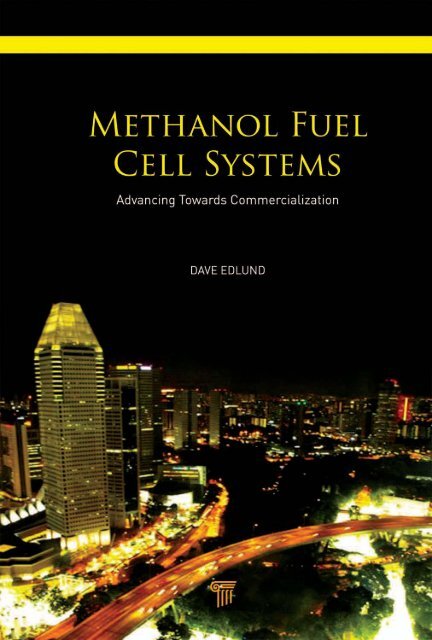Download PDF - Pan Stanford Publishing
Download PDF - Pan Stanford Publishing
Download PDF - Pan Stanford Publishing
You also want an ePaper? Increase the reach of your titles
YUMPU automatically turns print PDFs into web optimized ePapers that Google loves.
This page intentionally left blank
Published by<br />
<strong>Pan</strong> <strong>Stanford</strong> <strong>Publishing</strong> Pte. Ltd.<br />
Penthouse Level, Suntec Tower 3<br />
8 Temasek Boulevard<br />
Singapore 038988<br />
Email: editorial@panstanford.com<br />
Web: www.panstanford.com<br />
British Library Cataloguing-in-Publication Data<br />
A catalogue record for this book is available from the British Library.<br />
Methanol Fuel Cell Systems<br />
Copyright © 2011 by <strong>Pan</strong> <strong>Stanford</strong> <strong>Publishing</strong> Pte. Ltd.<br />
All rights reserved. This book, or parts thereof, may not be reproduced in any<br />
form or by any means, electronic or mechanical, including photocopying,<br />
recording or any information storage and retrieval system now known or to<br />
be invented, without written permission from the publisher.<br />
For photocopying of material in this volume, please pay a copying fee<br />
through the Copyright Clearance Center, Inc., 222 Rosewood Drive,<br />
Danvers, MA 01923, USA. In this case permission to photocopy is not<br />
required from the publisher.<br />
ISBN 978-981-4241-98-4 (Hardcover)<br />
ISBN 978-981-4303-14-9 (eBook)<br />
Printed in the USA
To my father and mother, who inspired and nurtured<br />
my lifelong love of science; to my wife, who has<br />
tirelessly supported and motivated me; and to<br />
my children, who have given me purpose.
This page intentionally left blank
Contents<br />
Preface<br />
xi<br />
1. Hydrogen Fuel Cell Technology 1<br />
1.1 Common Classifications 1<br />
1.2 PEMFC Construction and Basic Principles of<br />
Operation 3<br />
1.3 Low-temperature Pemfcs 8<br />
1.3.1 The Importance of Operating Temperature 9<br />
1.3.2 Operational Durability 11<br />
1.4 High-Temperature PEMFCs 11<br />
1.4.1 Future Potential of HT PEMFCs 13<br />
1.5 System Architecture and Balance-of-Plant 14<br />
1.5.1 Balance-of-Plant Component Selection 19<br />
1.5.1.1 Statistical analysis and lifetime 22<br />
1.5.1.2 Accelerated lifetime testing 25<br />
Notes 27<br />
2. Methanol as a Fuel 29<br />
2.1 Commercial Methanol Synthesis 30<br />
2.2 Physical Properties of Methanol 32<br />
2.2.1 Flammability Classifications 35<br />
2.2.1.1 Fuel packaging considerations 38<br />
2.2.1.2 Compatible materials 39<br />
2.2.1.3 Methanol purity concerns 40<br />
2.3 Environmental and Safety Issues 41<br />
2.3.1 Safety Hazards Due to Toxicity 43<br />
2.3.1.1 Use of aversion agents 45<br />
2.3.2 Safety Hazards Due to Fire 47<br />
Notes 48<br />
3. Methanol Reforming 51<br />
3.1 Methanol Steam Reforming 51
viii<br />
Contents<br />
3.1.1 System Design and Energy Balance 54<br />
3.1.1.1 Energy efficiency 58<br />
3.1.1.2 Methanol-reforming catalysts 59<br />
3.1.2 Reactor Designs 62<br />
3.1.2.1 Conventional packed-bed reactors 63<br />
3.1.2.2 Microchannel reactors 65<br />
3.1.2.3 Reactors using engineered catalyst<br />
supports 67<br />
3.1.2.3 Trade-offs: cost vs. functionality, sizing,<br />
durability 70<br />
3.2 Partial Oxidation and Autothermal Reforming 72<br />
3.2.1 System Design and Energy Balance 74<br />
3.2.1.1 Energy efficiency 76<br />
3.2.1.2 CPOx and ATR catalysts 77<br />
3.2.2 Reactor Designs 78<br />
3.3 Oxidative Methanol Reforming 79<br />
3.4 Commercial Sources and Technical Challenges 80<br />
Notes 82<br />
4. Hydrogen Purification 83<br />
4.1 Hydrogen Purification Applied to Methanol Reformers 84<br />
4.2 Chemical Purification Methods 84<br />
4.2.1 Water-Gas Shift Reaction 86<br />
4.2.2 Preferential Oxidation 88<br />
4.2.3 Selective Methanation 90<br />
4.2.4 Membrane Purification Methods 91<br />
4.2.4.1 Palladium-alloy membranes 94<br />
4.2.4.2 Modeling palladium-alloy membrane<br />
performance 97<br />
4.2.4.3 Economic considerations 99<br />
4.2.4.4 Membrane durability 103<br />
4.2.4.5 Integration with a methanol reformer 107<br />
4.3 Hydrogen Purification for High-temperature Pemfc 110<br />
4.3.1 Economic Considerations 112<br />
4.4 Commercial Sources and Technical Challenges 114<br />
Notes 115<br />
5. Membrane Reactors for Methanol Reforming 117<br />
5.1 Reactor Performance 118
Contents<br />
ix<br />
5.2 Combining Reaction With Separation 120<br />
5.2.1 Membrane Sizing 122<br />
5.2.2 Designing the Reaction Region of a Membrane<br />
Reactor 124<br />
5.2.3 Thermal Management 125<br />
5.3 Conclusion and Potential for Commercial Success 126<br />
Notes 128<br />
6. Barriers to Commercialization 129<br />
6.1 Commercial Status: Reformed-Methanol Fuel Cell<br />
Systems 129<br />
6.2 Commercial Status: Methanol Reformer Subsystems 133<br />
6.2.1 Prognosis for Further Development 137<br />
6.3 Systemwide Economic Analysis 139<br />
6.3.1 Methanol Reformer Subsystem 140<br />
6.3.2 Fuel Cell Subsystem 141<br />
6.3.3 Power Electronics 144<br />
6.3.4 Automated Controls 145<br />
6.4 Concluding Remarks 147<br />
7. Applications and Markets 149<br />
7.1 Consumer Electronics 149<br />
7.2 Portable Power 153<br />
7.3 Backup Power 156<br />
7.4 Transportation 158<br />
Notes 161<br />
8. Reformer Cost—Lessons Learned 163<br />
8.1 The Cost Barrier 163<br />
8.2 Designing for Low Cost 165<br />
8.3 Influence of Volume on Cost Reduction 169<br />
8.4 Summary 172<br />
Note 173<br />
Index 175
This page intentionally left blank
Preface<br />
Hydrogen. It is the lightest element, the first in the Periodic Table, the<br />
primary constituent of stars. It is the fuel that heats and lights Earth.<br />
Hydrogen is all around us. Combined with oxygen and/or carbon,<br />
hydrogen is present in water, plant and animal tissue, petroleum,<br />
natural gas, plastic, paper, and wood. And yet, as abundant as<br />
hydrogen is in chemically combined forms, it is not naturally available<br />
as the free element.<br />
This presents a challenge for the commercial success of fuel<br />
cell technology. Fuel cells ideally operate on pure hydrogen. But<br />
where is the hydrogen to come from, and how is it to be supplied<br />
to fuel cell products? There are surprisingly few options. Hydrogen<br />
manufactured at large plants may be compressed and distributed by<br />
truck in heavy steel cylinders in a variety of sizes. Or, hydrogen may<br />
be liquefied (an extremely energy-intensive process) and distributed<br />
in heavy cryogenic tanks. These approaches are economically<br />
and logistically disadvantaged because of the cost of transporting<br />
compressed hydrogen.<br />
In specialized applications, hydrogen may be generated by electrolysis<br />
using off-peak electric power; the hydrogen being stored<br />
for later local consumption by fuel cells to make electricity. A less<br />
expensive option is to generate hydrogen locally from available<br />
hydrocarbon or alcohol fuels using a chemical process generically<br />
called reforming. Regardless of the fuel, reforming converts<br />
hydrocarbons and alcohols—for that matter any carbon-containing<br />
material—into hydrogen and a mixture of carbon dioxide and<br />
carbon monoxide.<br />
One legacy of the Industrial Revolution is humankind’s reliance<br />
on thermal engines that produce mechanical work through the<br />
These large, centralized hydrogen plants may be based on thermochemical<br />
processes (traditional), electrolytic processes (water electrolysis), or<br />
thermal processes (solar or nuclear) that split water into hydrogen and<br />
oxygen at very high temperatures.
xii<br />
Preface<br />
combustion of fuels—initially coal or wood and later liquid hydrocarbons<br />
and natural gas. Because of this legacy, fuels as we know<br />
them have been highly refined for one purpose: to reliably burn<br />
under all intended operational conditions. Thus, commercial fuels are<br />
blends of many, perhaps hundreds, of organic compounds and additives<br />
such that the vapor pressure, viscosity, lubricity, emissions, etc.,<br />
of the fuel are controlled regardless of the environmental conditions<br />
(hot or cold) or source of the petroleum or gas feedstock. Because<br />
of this, commercial fuels are very difficult feedstocks for a chemical<br />
reactor that is normally engineered to operate with a specific chemical<br />
feedstock, rather than a variable blend. In addition, most fuels<br />
are derived from either petroleum or natural gas and consequently<br />
contain significant concentrations of organosulfur compounds. At<br />
temperatures less than about 700°C, organosulfur compounds will<br />
poison known commercial catalysts for fuel reforming.<br />
A little-known fuel that has been used for decades in racing<br />
engines is methanol, favored for its high octane rating and the fact that<br />
it generates little thermal radiation when it burns (contributing to<br />
greatly improved safety in the event of an accident). Methanol is also<br />
easily reformed to make hydrogen. This is the focus of this book.<br />
Methanol is arguably an ideal fuel for local reformation to make<br />
hydrogen. As a primary chemical building block, it is produced<br />
around the world from natural gas and other hydrocarbons or from<br />
renewable resources, including garbage, sewage, and biomass.<br />
Methanol is a global commodity: it is shipped across oceans in large<br />
tankers; on land it is shipped in rail cars and by tanker trucks, and in<br />
both plastic and steel barrels.<br />
Hydrogen can be chemically extracted from methanol relatively<br />
easily at intermediate temperatures by using either air or water as<br />
an oxidant. As with all reformation processes, the product hydrogen<br />
is combined with carbon monoxide and carbon dioxide. Indeed, it<br />
is the formation of carbon dioxide—a chemical conversion associated<br />
with a large release of energy—that drives the overall process<br />
resulting in production of hydrogen. If water is the oxidant, onethird<br />
of the product hydrogen comes from water, making this the<br />
preferred route.<br />
Unlike hydrocarbon fuels, methanol is completely miscible with<br />
water, and such mixtures will not freeze even in the coldest climates.
Preface<br />
xiii<br />
Methanol also disperses quickly (by virtue of water miscibility) if<br />
spilled. Methanol is a naturally occurring compound that is produced<br />
as a by-product of spoiled fruit and the decay of sewage. Naturally<br />
occurring microbes metabolize methanol quickly, and if spilled on<br />
the ground or in water, methanol is degraded in a matter of days to<br />
a couple weeks.<br />
Despite all the reasons that methanol is a good choice for generating<br />
hydrogen, it has one major drawback: methanol is poisonous.<br />
Of course, the same is true for gasoline, diesel, and other fuels. Even<br />
ethanol is poisonous in sufficient quantity. However, methanol has<br />
a notorious history of being used illicitly to make cheap booze, frequently<br />
resulting in blindness, and even death, of innocent patrons.<br />
This history has resulted in an irrational fear of methanol by many<br />
individuals, companies, and governments. Only recently has a more<br />
balanced perception of methanol emerged, perhaps due in part to<br />
the success of SFC Energy AG’s direct-methanol fuel cell products<br />
sold for recreational use.<br />
As the title suggests, this book will examine in detail the use of<br />
methanol reformers in fuel cell systems. The book is aimed at those<br />
with a technical interest in methanol reformers as well as a business<br />
interest. Chapters are devoted to a discussion of methanol as a fuel,<br />
the chemical and engineering aspects of reforming methanol, and<br />
practical approaches to hydrogen purification (since relatively highpurity<br />
hydrogen is needed for low-temperature fuel cells). A recurring<br />
theme is cost reduction, since the purchase price of methanol<br />
reformers (and fuel cells) has historically been a significant barrier<br />
to widespread commercial acceptance. The latter half of the book<br />
addresses potential markets and applications and also delves into the<br />
cost issues in detail. These chapters offer value not only to design<br />
engineers but also to marketers and managers who are engaged with<br />
prospective customers for fuel cell systems and reformers.<br />
Bridging the gap between what a customer thinks he or she<br />
wants, and what can be economically delivered, is as much an art<br />
as it is a science. Through an understanding of the chemical and<br />
engineering fundamentals of methanol reformers and fuel cells, as<br />
well as the factors governing product cost, marketing and business<br />
managers will be better able to interface with customers and arrive<br />
at a pragmatic product description.
xiv<br />
Preface<br />
As much as possible, accurate economic information related<br />
to the cost of reformers, hydrogen purifiers, and components is<br />
included. To the best of my knowledge, this represents the first<br />
published discussion of real and actual costs associated with<br />
methanol reformers and hydrogen purification. However, the<br />
reader should be reminded that economic information may change<br />
quickly and the data included herein are only warranted to be<br />
accurate as of April 2010.<br />
Despite the slow pace of commercialization, fuel cell companies<br />
still enjoy a surprising level of public support and interest. Perhaps<br />
one reason is that societies around the world enjoy the use of<br />
electrical power in ways never imagined one and two generations<br />
ago. One could safely argue that the most developed countries are<br />
addicted to electricity, while the least developed countries need more<br />
access to electricity to improve the quality of life as well as increase<br />
life expectancy. Beginning with the Industrial Revolution we have<br />
witnessed an evolution in engine technology and fuels that engines<br />
run on. For sure, engines are great for converting chemical energy<br />
to mechanical energy, such as is needed for motive applications.<br />
But mechanical energy offers less utility in the Digital Age, where<br />
we enjoy and rely on a vast assortment of solid-state devices that<br />
require DC electrical power.<br />
The generation of electricity by the conventional two-step<br />
processes of first converting chemical energy to mechanical energy<br />
and then converting mechanical energy to electricity is becoming<br />
obsolete. Over the next few decades we should expect and demand<br />
that a greater portion of the electrical power we use daily be<br />
produced by more efficient and/or versatile one-step processes<br />
such as fuel cells and solar generation. Fuel cell technology provides<br />
a one-step process for the conversion of chemical energy directly<br />
to DC electrical energy. In this sense, fuel cells may be thought of<br />
as batteries that never run down or need charging provided fuel is<br />
maintained in the fuel tank.<br />
At the time this text is being written, fuel cell systems operating on<br />
reformed methanol still have not been broadly commercialized, but<br />
commercial traction is gaining. Although most of the technological<br />
barriers have been removed, successful products must also be
Preface<br />
xv<br />
competitively priced. Although engineers and scientists may find<br />
new technology exciting and worthy in its own right, customers will<br />
always, to a large degree, make their purchasing decisions on the<br />
basis of price. Succeeding at developing new technology is only a<br />
part of the battle; to win, products must also be affordable.<br />
April 2010<br />
Dave Edlund
This page intentionally left blank

















